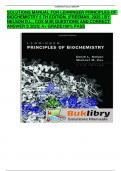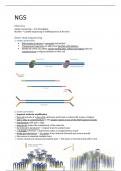Tentamen (uitwerkingen)
SOLUTIONS MANUAL FOR LEHNINGER PRINCIPLES OF BIOCHEMISTRY 5 TH EDITION. (FREEMAN, 2025 ) BY NELSON D.L., COX M.M| QUESTIONS AND CORRECT ANSWER S 2025| A+ GRADE100% PASS
- Vak
- Instelling
- Boek
SOLUTIONS MANUAL FOR LEHNINGER PRINCIPLES OF BIOCHEMISTRY 5 TH EDITION. (FREEMAN, 2025 ) BY NELSON D.L., COX M.M| QUESTIONS AND CORRECT ANSWER S 2025| A+ GRADE100% PASS
[Meer zien]






